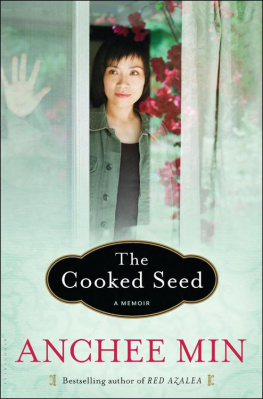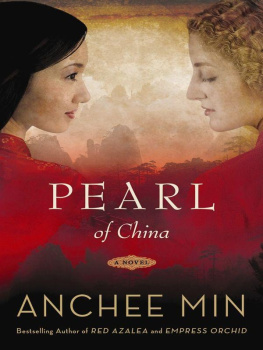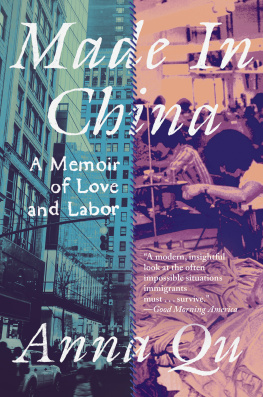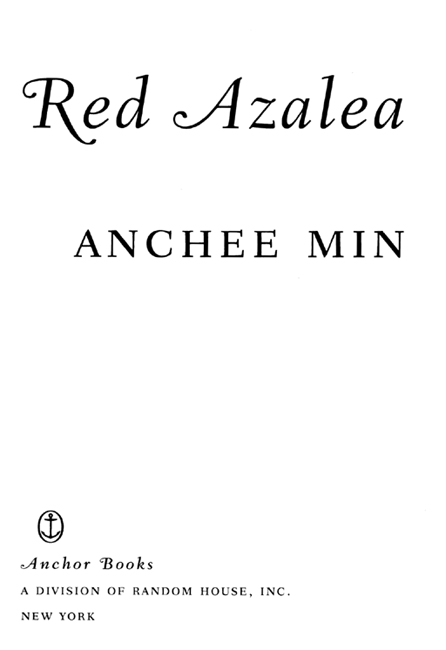Born in Shanghai in 1957, Anchee Min came to America in 1984. While attending English as a Second Language classes, she worked as a waitress, a house cleaner, a fabric painter, and a model. In 1990 she received a Masters of Fine Arts Degree from the Art Institute of Chicago. Min wrote Red Azalea in English over an eight-year period. It won the Carl Sandburg Literary Award in 1993 and was a New York Times Notable Book.
ALSO BY ANCHEE MIN
Katherine
Becoming Madame Mao
Wild Ginger
Empress Orchid
FIRST ANCHOR BOOKS EDITION, APRIL 2006
Copyright 1994 by Anchee Min
Preface copyright 2006 by Anchee Min
All rights reserved. Published in the United States by Anchor Books, a division of Random House, Inc., New York, and in Canada by Random House of Canada Limited, Toronto. Originally published in hardcover in a slightly different form in the United States by Pantheon Books, a division of Random House, Inc., New York, in 1994.
Anchor Books and colophon are registered trademarks of Random House, Inc.
The Library of Congress has cataloged the Pantheon edition as follows:
Min, Anchee, 1957
Red azalea / Anchee Min.
p. cm.
1. Min, Anchee, 1957. 2. ChinaHistoryCultural Revolution, 19661969Personal narratives. I. Title.
DS778.7.M56 1994
951.05092dc20 93-9038
eISBN: 978-0-307-78102-4
www.anchorbooks.com
v3.1
To Qigu
Acknowledgments
Thank you:
Sandra Dijkstra, my agent, for your discovery.
Joan Chen, my comrade-in-arms, for your inspiration.
Xian-Ming Yuan, for your enlightenment since Shanghai 51st Middle School.
Michele Dremmer, for your affection.
Diana and Richard K. M. Eu, my aunt and uncle; Mr. S. G. Lee of the Singapore Lee Foundation; and Harris Meyer and Deborah Mihm, for your sincere support.
Michele Smith, for helping me with my English since I arrived in the United States.
Vincent Yip, my brother-in-law, for being my walking dictionary.
Yan-Fang Jiang and Ci-Feng Zhang, my parents-in-law, for baby-sitting Lauryan.
Julie Grau, for your energy and for your faith in the book.
Dan Frank, my editor, thank you.
Contents
Authors Note
I have translated the Chinese names according to their original meaning instead of transcribing them phonetically. I have changed some names in order to protect lives.
PREFACE
I never expected that the message in Red Azalea would still be significant ten years after its publication. The Communist government of China continues to deny its past. Children today know Mao as a hero instead of the one who should be held responsible for the Cultural Revolution (19641976), which brought destruction to every family in the nation and took millions of lives.
In America I have tried to bury my own memories. Yet, I see Little Greens drowned face in the fireworks on the Fourth of July. Every time I visit the toilet I remember how I used to squat on a thin, wet board over a manure-pit with millions of maggots swimming below me and my fear of falling in. Every time I have loved, I hear the sound of a bullet and am reminded of the price of falling in love at the labor camp and what happened to those who paid for passion.
My young American-born daughters dream of becoming the one who would help to discover the cure for cancer reminds me of my own childhood dream of devoting myself to protecting my country. I wanted to tie grenades to my body and become a martyr by blowing up the Vietnam invaders, the Americans.
It saddens me to see that the Chinese historians echo the governments line, which calls the Cultural Revolution Maos tiny flaw, in other words, Not worthy of mentioning.
I havent taken the publication of Red Azalea for granted, because I know that millions of my people did not live to tell their stories.
The record of history is set by the powerful. While I credit the Communist government for Chinas economic success, I despise its attitude toward the past. I consider the regimes new slogan, Comrades, lets move on, which translates as, Lets forget about the Cultural Revolution, an act of betrayal against humanity.
Wrapped in fancy neon lights, our souls landscape is a ruin and is infected with disease. We hope that the sickness wont show and the tumor wont grow and spread. What could be more frightening? How long will it be until the unlearned lesson repeats itself?
When I wrote Red Azalea I didnt realize that it not only told a story of a girl named Jade of Peace, Anchee Min, but also the story of China, its yesterday, today, and tomorrow.
Anchee Min, 2005
Part ONE
I was raised on the teachings of Mao and on the operas of Madam Mao, Comrade Jiang Ching. I became a leader of the Little Red Guards in elementary school. This was during the Great Proletarian Cultural Revolution when red was my color. My parents lived likeas the neighbors described thema pair of chopsticks: always in harmony. My father was an instructor of industrial technique drawing at Shanghai Textile Institute, although his true love was astronomy. My mother was a teacher at a Shanghai middle school. She taught whatever the Party asked, one semester in Chinese and the next in Russian. My parents both believed in Mao and the Communist Party, just like everybody else in the neighborhood. They had four children, each one a year apart. I was born in 1957. We lived in the city, on South Luxuriant Road in a small two-story townhouse occupied by two families. The house was left by my grandfather, who had died of tuberculosis right before I was born.









